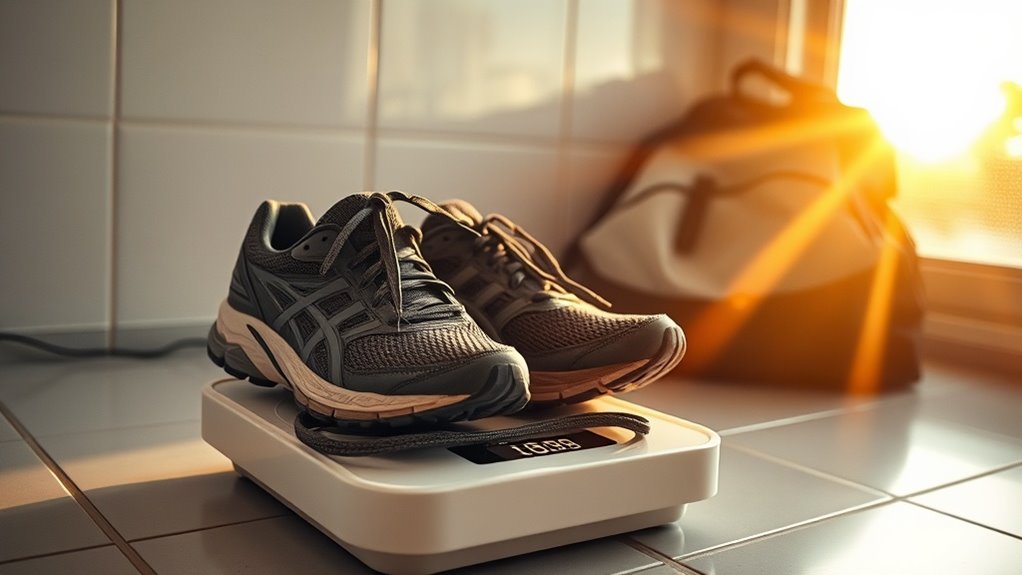She Made These Tiny Changes-Now She’s Down 25 Pounds and Glowing
You might wonder how simple tweaks, like swapping sugary drinks for water, could lead to a 25-pound loss and more energy. These evidence-based changes, from mindful eating to daily walks, offer a balanced path to lasting results. Imagine what they’d do for you—let’s explore the next steps.
Key Takeaways
- Swap sugary drinks for water to cut calories and enhance hydration, as a simple daily habit.
- Opt for whole, nutrient-dense foods over processed ones to increase satiety and support weight loss.
- Incorporate daily walks or short exercises to boost metabolism and improve overall energy.
- Practice mindful eating by chewing thoroughly and eating without distractions to control portions.
- Prioritize 7-9 hours of sleep nightly to regulate hunger hormones and maintain long-term progress.
Small Dietary Swaps That Made a Big Difference
When you’re aiming for weight loss, simple dietary swaps can yield surprising results.
By making small changes for big weight loss, you can replace sugary beverages with water to cut hidden calories and boost hydration. Swap refined grains like white bread for whole grains, which provide more fiber to keep you satisfied longer.
Evidence from studies, such as those in the American Journal of Clinical Nutrition, shows these tweaks reduce overall intake without strict diets.
Balance is key—enjoy treats occasionally while focusing on nutrient-dense foods for sustainable progress.
Track your swaps to see the difference.
Additionally, consider swapping chips with air-popped popcorn for a crunchy, low-calorie snack.
Incorporating Easy Daily Exercises
You can kickstart your weight loss efforts by starting with walking, a low-impact activity that studies show boosts calorie burn without overwhelming your schedule.
Next, add daily stretches to enhance flexibility and reduce injury risk, making them a practical complement to your routine.
Finally, try quick workouts like bodyweight exercises to build strength efficiently, ensuring you maintain balance by listening to your body’s limits.
To amplify your progress, integrate a 5-minute routine that includes simple exercises aimed at engaging your core and elevating your heart rate.
Start With Walking
Embark on weight loss by starting with walking, a low-impact exercise backed by studies showing it effectively burns calories and improves heart health.
You can begin with brisk 20-30 minute walks daily, using your neighborhood or a treadmill, which helps build endurance without overwhelming your body.
Research from the American Heart Association indicates that consistent walking lowers BMI and enhances metabolism.
It’s accessible for all fitness levels, requiring no special gear, but remember to track progress and listen to your body to avoid overexertion.
Combine it with healthy eating for balanced results, making it a sustainable step toward your goals.
Add Daily Stretches
Building on your walking habit, daily stretches offer a simple way to boost flexibility and aid weight loss by enhancing muscle recovery and calorie burn.
You’ll improve joint mobility and reduce injury risk with routines like gentle neck rolls, arm circles, and forward bends—aim for 10-15 minutes daily.
Studies show stretching increases blood flow, supporting fat metabolism, while easing muscle tension from walks.
Keep it balanced; pair with proper form to avoid strain, and listen to your body.
It’s an easy, low-impact addition that complements your routine, fostering long-term health without overwhelming you.
Try Quick Workouts
How can quick workouts amplify your weight loss journey?
Research shows that brief, daily exercises boost metabolism and burn calories efficiently, as seen in studies from the American Council on Exercise.
For example, a 10-minute walk or bodyweight routine like squats and planks increases energy expenditure without demanding much time.
You’re building sustainable habits that enhance fat loss and mood, but balance them with rest to avoid burnout.
Pair these with nutrition and stretches for optimal results—small efforts add up, just like in the story of shedding 25 pounds through consistent tweaks.
Building Better Hydration Habits
Hydration forms the foundation of your daily health routine, influencing everything from energy levels to weight control.
Evidence shows that adequate water intake supports metabolism and curbs cravings, as dehydration can mimic hunger.
You’re building better habits by starting small: aim for half your body weight in ounces daily, like 64 ounces if you weigh 128 pounds.
Use apps to track progress and set reminders, turning hydration into a routine.
Infuse water with cucumber or lemon for appeal, and listen to your body’s thirst cues.
Balance is key—overhydration risks exist, so sip mindfully for sustained energy and weight loss support.
Additionally, aiming for 16 ounces of water before meals can help prevent overeating and support your weight loss goals.
Mindful Eating Techniques for Success
You can boost your weight loss efforts by savoring each bite, which lets you appreciate flavors and naturally slow down your eating.
You’ll eat without distractions like TV or phones, helping you focus on your meal and recognize when you’re satisfied.
Tuning into your hunger cues ensures you stop eating at the right time, balancing your intake with your body’s needs.
Additionally, try the 10-Second Trick to pause before each bite and assess if you’re truly hungry.
Savor Each Bite
Savoring each bite enhances your eating experience by encouraging full awareness of flavors and textures.
Research indicates this technique promotes better digestion and portion control, as you’re more likely to eat until satisfied, not stuffed.
Start by chewing thoroughly—aim for 20-30 chews per bite—to fully appreciate your food.
This mindful approach, supported by studies from the American Journal of Clinical Nutrition, helps regulate hunger hormones like ghrelin.
You’ll enjoy meals more, fostering sustainable habits that aid weight loss without extreme diets.
Balance it with variety to keep things interesting and effective.
Eat Without Distractions
Eating without distractions is key to mastering mindful eating, as it allows you to fully engage with your food and body’s signals.
Studies, like those from the American Journal of Clinical Nutrition, indicate that distractions increase calorie intake by up to 25% due to reduced awareness.
You can implement this by designating a distraction-free zone for meals—turn off your phone, step away from the TV, and savor the experience.
This practical approach fosters better portion control and enjoyment, but balance it with realistic goals; start with one meal a day to build the habit without overwhelming yourself.
Tune Into Hunger
How can you effectively tune into your body’s hunger signals?
First, pause and rate your hunger on a 1-10 scale before meals, a technique backed by research showing it curbs overeating.
Eat slowly, focusing on flavors and textures, which gives your brain 20 minutes to register fullness, as studies confirm.
Differentiate true hunger from emotional triggers by practicing deep breathing beforehand.
Avoid distractions to stay present.
These evidence-based strategies promote balanced, intuitive eating without restriction, fostering sustainable weight loss when combined with other habits.
Enhancing Sleep and Energy Levels
Why focus on sleep when aiming for weight loss? Poor sleep disrupts hormones like ghrelin and leptin, increasing hunger and cravings while reducing your body’s ability to burn fat. Studies show that getting 7-9 hours nightly boosts metabolism and energy, helping you make better food choices and stay active. You’re more likely to skip that extra snack when rested. Practically, create a calming bedtime routine—dim lights, avoid screens, and relax with a book. Balance this with realistic goals; it’s not a quick fix but a sustainable step toward glowing health and easier weight management. Moreover, sleep deprivation can elevate cortisol levels, leading to stress and further weight gain challenges.
Creating a Supportive Routine for Lasting Results
When you establish a supportive routine, you’ll weave in habits that sustain weight loss over time.
Begin with consistent exercise, like daily walks or strength sessions, as research shows this boosts metabolism and maintains muscle.
Plan meals ahead with balanced nutrients—think veggies, proteins, and whole grains—to curb overeating while allowing treats for realism.
Track progress via a simple journal, fostering accountability without obsession.
Utilize food journaling to identify patterns in your eating habits and enhance awareness for better weight management.
Include rest and flexibility, since studies highlight that adaptable routines reduce burnout and relapse.
This evidence-based approach ensures lasting results, keeping you motivated and glowing long-term.





